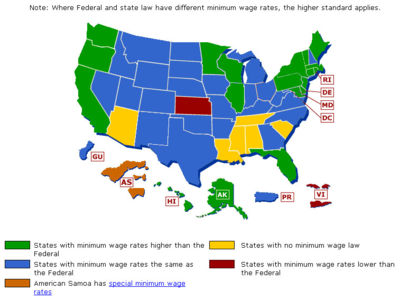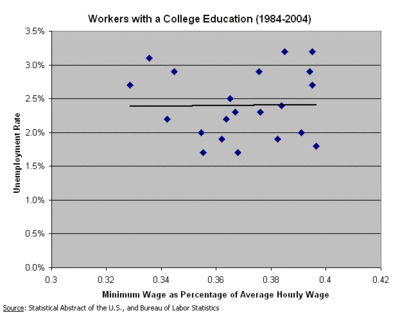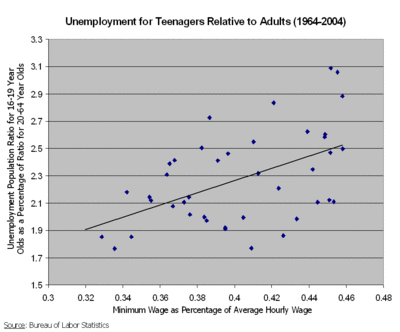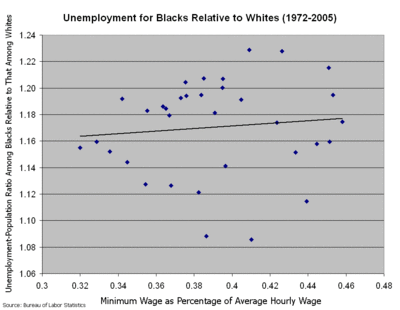Minimum wage
2007 Schools Wikipedia Selection. Related subjects: Economics
Minimum wage is the minimum hourly, daily or monthly wage that must be paid to employees or workers. Each country sets its own minimum wage laws and regulations, and more than 90% of all countries have some kind of minimum wage legislation.
The first national minimum wage law was enacted by the government of New Zealand in 1896, followed by Australia in 1899 and United Kingdom in 1902. In the United States, statutory minimum wages were first introduced nationally in 1938, and in the United Kingdom in 1999. In the European Union, 18 out of 25 member states currently have national minimum wages. Many countries, such as Norway, Sweden, Finland, Denmark, Switzerland, Germany, Austria, Italy, and Cyprus have no minimum wage laws, but rely on employer groups and trade unions to set minimum earnings through collective bargaining and through the so called "invisible hand" of the market which adjusts the wage in function of demand and competition.
Supporters assert that the minimum wage is a matter of social justice which helps reduce exploitation and ensures that workers can afford basic necessities (cf. living wage). Supporters deny claims of causal links between the minimum wage and adverse impacts upon employment, and suggest that in any event, greater social benefit derives from the minimum wage. Detractors contend that a minimum wage increases unemployment among low wage workers, thus harming rather than helping the poorest workers. Some also argue that it slows economic growth.
Minimum wage legislation may be interpreted as making it either unlawful for employers to pay workers less than the minimum wage, or unlawful for workers to provide labor or services for less than the minimum. For example, during the apartheid era in South Africa, white trade unions lobbied for the introduction of minimum wage laws so as to exclude black workers from the labor market. By preventing black workers from selling their labor for less than white workers, the black workers were prevented from competing for jobs held by whites. Although it is the employer who is fined and/or imprisoned for violations, the workers also lose their freedom, albeit indirectly.
Legislation in the Western Industrialized World
The first moves to legislate wages did not set minimum wages, rather the laws created arbitration boards and councils to resolve labour conflicts before the recourse to strikes.
- In 1896, New Zealand established such arbitration boards with the Industrial Conciliation and Arbitration Act
- In 1899, the state of Victoria, Australia established similar boards
- In 1907, the 'Harvester decision' was handed down in Australia. It established a 'living wage' for a man, his wife and two children to "live in frugal comfort"
The established similar boards
- In 1909, the Trade Boards Act was enacted in the United Kingdom, establishing four such boards
- In 1912, the state of Massachusetts, United States, set minimum wages for women and children
- In the 1960s minimum wage laws were introduced into Latin America as part of the Alliance for Progress; however these minimum wages were, and are, low.
In the United States and other countries, minimum wage laws were a common demand of labor unions.
Australia
- The notion of a 'basic wage' was first established in 1907 with the Harvester Judgement.
- The current federal minimum wage for full or part time employees aged over 21 in Australia is $13.47 AUD (~$10.50 U.S. Dollars) per hour. [ ]
- In 2005, the Federal Government implemented significant changes to the nation's labour system. These changes do not explicitly lower the minimum wage (in nominal terms) but may slow its rate of increase. See also, Australian Industrial Relations Law Reform 2005
New Zealand
- The current minimum wage in New Zealand for adults aged 18 or over is $10.25 per hour. The current minimum rate for workers aged 16-18 or apprentices of any age is $8.20, or 80% of the adult rate
Canada
Under the Canadian Constitution's federal-provincial division of powers, the responsibility for enacting and enforcing labour laws rests with the ten provinces; the three territories also having been granted this power by virtue of federal legislation. This means that each province and territory has its own minimum wage. The lowest general minimum wage in force as of July 2006 is that of New Brunswick ( $6.70/hour), the highest is that of Nunavut ( $8.50/hour). Some provinces allow lower wages to be paid to liquor servers and other tip earners, and/or to inexperienced employees. British Columbia allows employers to pay as little as $6/hour to an inexperienced worker.
The federal government could theoretically set its own minimum wage rates for workers in federal jurisdiction industries ( railways for example). As of 2006 however, the federal minimum wage is defined to be the general adult minimum wage rate of the province or territory where the work is performed. This means, for example, that a railway company could not legally pay a worker in British Columbia less than $7/hour regardless of the worker's experience.
France
- The current (July 2006) minimum wage in France is set at 8.27€ (EUR) per hour (~10.46 US dollars). In 2004, 15% of the working population received the minimum wage.
Ireland
- Ireland's minimum wage was introduced in 2000, and is currently € 7.65 an hour, although a complex set of exemptions means that some people may be paid as little as 70% of this (€ 5.36), and it may further be reduced by up to € 7.73 a day if lodgings or food are provided as part of a job. Due to general difficulties in finding employees, virtually no jobs pay the minimum wage, with only 3.1% of employees receiving it in 2004.
United Kingdom
Municipal regulation of wage levels began in some towns in 1524. Later, the Trade Boards Act of 1909 initially created four Trades Boards that set minimum wages which varied between industries for a number of sectors where 'sweating' was generally regarded as a problem and where collective bargaining was not well established. This system was extended considerably after the Second World War; in 1945 Trades Boards became Wage Councils, which set minimum wage standards in many sectors of the economy, including the service sector as well as manufacturing. Wage Councils were finally abolished in 1993, having fallen into decline due, in large part, to Trades Union opposition. A lower limit of pay, or 'pay floor' was regarded as threatening the voluntary system of collective bargaining favoured in the UK. Government had first made a serious attempt to abolish Wage Councils in 1986, having abandoned existing legislation that tried to widen the scope of voluntary agreements to include those firms that had not taken part in negotiations, such as the Fair Wages Resolutions. These required that government contractors pay fair wages and respect the rights of their employees to be members of trades unions.
A national minimum wage was introduced for the first time by Prime Minister Tony Blair's Labour government in April 1999, at the rate of £3.60 (US$5.78 at 1st April 1999 rate) per hour for those workers aged 22 and over. This rate was set after the Low Pay Commission, an independent body the Government appointed in July 1997 to advise it on low pay, recommended the rate. The LPC exists to this day to maintain the national minimum wages, which are uprated following its recommendations each October. The LPC board consists of nine members - three trade unionists, three employers, and three labour market relations experts. The Commission is widely regarded as a successful example of a 'social partnership', and undertakes consultations each year in order to gather all available evidence before making its recommendations.
The current minimum wage in the UK for adults aged 22 or older is £5.35 ($10.01US), compared with $5.15 in the US. For workers between the ages of 18 and 21, or any workers who are in the first six months of their job and receiving accredited training, the minimum wage is £4.45 ($8.33US) per hour. The minimum hourly wage for all workers under the age of 18 (who are no longer of compulsory school age) is £3.30 ($6.18US). There is no minimum wage for those still of compulsory school age.
Some workers undertaking apprenticeships or accredited training can be exempted for a certain amount of time; this varies according to their age and the length of time they have been in employment. Other categories of worker who are exempt include Au Pairs, Share Fishermen, Clergy, those in the Armed Forces, Prisoners and some people working in family businesses.
There are some areas in which minimum wage legislation becomes complex, including the aforementioned exemptions for apprentices and trainees and cases where the accommodation offset applies.
Unlike other areas of employment rights legislation in the UK, the National Minimum Wage has compliance teams to support its enforcement. Workers who think they are being paid less than the minimum wage can either make a complaint directly to HM Revenue and Customs on 0845 6000678 or seek advice from another source such as their local Citizens Advice Bureau or the Scottish Low Pay Unit - this is particularly recommended if other employment rights issues are involved, as the HMRC can only deal with minimum wage enquiries.
United States
The first attempt at establishing a minimum wage in the United States came in 1933, when a $.25-per-hour standard was set as part of the National Industrial Recovery Act. However, in 1935's Schechter Poultry Corp. v. United States (295 U.S. 495), the United States Supreme Court declared the act unconstitutional, and the minimum wage was abolished.
The minimum wage was re-established in the United States in 1938 (pursuant to the Fair Labor Standards Act), once again at $.25 per hour ($3.22 in 2005 dollars). It had its highest purchasing value ever in 1968, when it was $1.60/hour ($9.12 in 2005 dollars.) The current federal minimum wage is now $5.15 an hour.
During his presidency, Bill Clinton gave states the power to set their minimum wages above the federal level. As of April 2006, 18 states had done so. Community organizing efforts initiated by ACORN were responsible for the increases in some states such as Florida, Nevada, and Ohio. Some government entities, such as counties and cities, observe minimum wages that are higher than the state as a whole. One notable example of this is Santa Fe, New Mexico, whose $9.50-per-hour minimum wage is currently the highest in the nation, while New Mexico itself observes the federal minimum. Another device to increase wages, living wage ordinances, generally apply only to businesses that are under contract to the local government itself.
On November 7, 2006, voters in six states (Arizona, Colorado, Missouri, Montana, Nevada, and Ohio) approved state-wid increases in the state minimum wage. The amounts of these increases ranged from $1 to $1.70 an hour and all increases are designed to annually index to inflation.
Many progressive politicians in the United States advocate linking the minimum wage to the Consumer Price Index, thereby producing small annual increases rather than the larger hikes that tend to be adopted when legislation to do so is passed. So far, Ohio, Oregon and Missouri have linked their minimum wages to the consumer price index.
Minimum wage jobs rarely include health insurance coverage , although that is changing in some parts of the USA where the cost of living is high, such as California, and at some companies. For instance, Trader Joe's supermarkets give part-time employees health coverage.
Other countries
- The current (2006) "monthly income for a full-time employee earning the national minimum wage" for twenty industrialised countries can be found here.
Debate over consequences of minimum wage laws
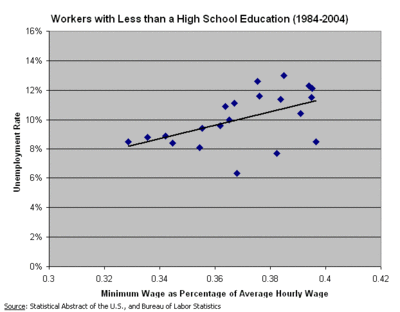
Classical microeconomic theory (Supply and Demand) says that by mandating a price floor above the equilibrium wage, minimum wage laws cause unemployment. This is because a greater number of workers are willing to work at the higher wage while a smaller numbers of jobs will be available at the higher wage. Companies can be more selective in who they employ thus the least skilled and unexperienced will typically get excluded.
There are many other variables that can complicate the issue such as Monopsony in the labour market, whereby the individual employer has some market power in determining wages paid. Whilst single employer market power seems extremely unlikely to exist in most labour markets if understood in terms of the traditional 'company town' exposition, information and mobility imperfections, together with the 'personal' element of the labour transaction give some degree of wage-setting power to the majority of firms.
Economists disagree as to the measurable impact of minimum wages in the 'real world'. This disagreement usually takes the form of competing empirical tests of the elasticities of demand and supply in labor markets and the degree to which markets differ from the perfectly competitive efficient ideal.
A 2003 survey by Dan Fuller and Doris Geide-Stevenson reports that 46% of academic economists in the US fully agreed with the statement, "a minimum wage increases unemployment among young and unskilled workers", 28% partly agreed, and 27% disagreed. The authors of this study also reweighted data from a 1990 sample to show that at that time 62% of academic economists agreed with the statement above, while 19.5% partly agreed and 17.5% disagreed.
In the debate about minimum wage it is rarely mentioned by how much the quantity of labor demanded may fall if the minimum wage is raised. Research papers by the Employment Policies Institute and by the conservative National Centre for Policy Analysis claim that increases of 10% in the minimum wage may reduce demand hours worked at the minimum wage by around 1% or 2% depending on circumstances.
According to a claim by the Mackinac Centre for Public Policy, the passage of the first Federal mandated minimum wage in the United States in 1933 led to an estimated 500,000 blacks losing their jobs via replacement by higher skilled and more educated white laborers. Milton Friedman, 1976 Nobel Prize winner in Economics, called the minimum wage one of the most "anti-negro laws" for what he saw as its adverse affects on employers. However, most sources show that one out of five blacks is directly benefited by the minimum wage, and indeed African Americans support increasing the minimum wage at slightly higher levels than Americans as a whole.
Today, the International Labour Organization (ILO) and the OECD do not consider that the minimum wage can be directly linked to unemployment in countries which have suffered job losses.
Costs and benefits
Supporters of the minimum wage claim it has these effects:
- Increases the average living standard.
- Reduces worker exploitation.
- Can increase the economic efficiency of the economy where labour markets exhibit a high degree of market power on the part of employers.
- Forces employers to recognise the inherent worth of human labor.
- Stimulates consumption, by putting more money in the hands of low-income people who spend their entire paychecks .
- Stimulates economic growth by discouraging labor-intensive industries, thereby encouraging more investment in capital and training .
- Increases the work ethic of those who earn very little, as employers demand more return from the higher cost of hiring these employees.
- Decreases the cost of government social welfare programmes through increasing labour supply amongst the low skilled.
- Prevents in-work benefits (e.g. the Earned Income Tax Credit and the Working Tax Credit) from causing a reduction in gross wages which would otherwise occur if labour supply is not perfectly inelastic .
- Provides a 'shock' which forces employers to use a high productivity strategy rather than a high labour turnover strategy, therefore improving the stock of Human Capital in an economy.
Opponents of the minimum wage claim it has these effects:
- Reduces demand for workers.This may manifest itself through a reduction in the number of hours worked by individuals, or through a reduction in the number of jobs .
- Reduces profit margins of business owners employing minimum wage workers.
- Increases prices for customers of employers of minimum wage workers, which would pass through to the general price level.
- Reduces economic growth by skewing factor-choice incentives away from the optimum choice.
- Decreases opportunities for low-skilled workers to gain the training and responsibility they need to move up the wage ladder
- Increases the cost of government social programs due to assistance programs aiding the laid-off workers
- Is less effective at reducing social exclusion than some other alternatives, for example training programs.
- Is less effective than the Earned Income Tax Credit at targeting the truly needy, and is more damaging to businesses .
- Decreases human capital by encouraging people to enter the job market instead of pursuing further education.
- Reduces the international competitiveness of a nation by raising the cost of factor inputs, and therefore output, relative to the level of other countries. It is argued that this is particularly problematic in developing economies .
The aforementioned arguments, both pro and con, are largely empirical in nature. That is, debate of these arguments centers on the application of data and analytic techniques. By contrast, debate of theoretical arguments (see below) centre on the application of logical reasoning.
Some labor union contracts are based on the minimum wage; this produces a natural constituency to lobby for increases among union workers who typically earn more than the minimum . Some public grants or taxes are also based on a multiple of the minimum wage, and this also can produce lobbying incentives in either direction. (For example, a worker may have an exemption if his earnings are below 2.5 times the minimum wage.)
Recent trends in the U.S.
Some idea of the empirical problems of this debate can be seen by looking at recent trends in the United States. The minimum wage fell about 29% in real terms between 1979 and 2003. For the median worker, real hourly earnings have increased since 1979, however for the lowest deciles, there have been significant falls in the real wage without much fall in the rate of unemployment. Some argue that a declining minimum wage might reduce youth unemployment (since these workers are likely to have fewer skills than older workers). Over all, there is no consensus between economists about the effects of minimum wages on youth employment, although empirical evidence suggests that this group is most vulnerable to too high minimum wages.
Scholarly articles
Views of Card and Krueger
The more common debate is on changes to minimum wages. This unified view was challenged by research done by David Card and Alan Krueger. In their 1997 book Myth and Measurement: The New Economics of the Minimum Wage ( ISBN 0-691-04823-1), they argued the negative employment effects of minimum-wage laws to be minimal if not non-existent (at least for the United States). For example, they look at the 1992 increase in New Jersey's minimum wage, the 1988 rise in California's minimum wage, and the 1990-91 increases in the federal minimum wage. In each case, Card and Krueger present evidence ostensibly showing that increases in the minimum wage led to increases in pay, but no loss in jobs. That is, it appears that the demand for low-wage workers is inelastic. Also, these authors reexamine the existing literature on the minimum wage and argue that it, too, lacks support for the claim that a higher minimum wage cuts the availability of jobs.
Critics of this research, however, argue that their research was flawed. For example, Card and Krueger gathered their data by telephoning employers in Pennsylvania and New Jersey, asking them whether they intended to increase, decrease, or make no change in their employment. Subsequent attempts to verify the claims requested payroll cards from employers to verify employment, and ostensibly found that the minimum wage increases were followed by decreases in employment. On the other hand, an assessment of data collected and analysed by David Neumark and William Wascher, economists who are usually critical of minimum-wage increases, did not initially contradict the Card/Krueger results, but in a later edited version found that the same general sample set did increase unemployment. See Neumark Waschler, American Economic Review, Volume 90 No. 5.
Another possible explanation on why minimum wage laws may not decrease unemployment in the United States is that the minimum wage is set close to the equilibrium point for low and unskilled workers, thus absent the minimum wage law and unskilled workers would be paid approximately the same amount. However, a dramatic increase above this equilibrium point would likely bring about increased unemployment for the low and unskilled workers.
Agreement with Card and Krueger
Since the introduction of a national minimum wage in the UK in 1999, its effects on employment were subject to extensive research and observation by the Low Pay Commission. The Low Pay Commission found that, rather than make employees redundant, employers have reduced their rate of hiring, reduced staff hours, increased prices, and have found ways to cause current workers to be more productive (especially service companies). Neither trade unions nor employer organisations contest the minimum wage, although especially the latter had done so heavily until 1999.
From the other side, some leading economists accept the Card/Krueger works and agree with their results .
Disagreement with Card and Krueger
The Joint Economic Committee (having at the time a Republican majority) of the United States Congress has been critical of Card and Krueger's work. They note that it conflicts with other studies done on minimum wage laws within the United States over the past 50 years. According to the JEC, minimum wage laws have been shown to cause large amounts of unemployment, especially among low-income, unskilled, black, and teenaged populations, as well as cause a host of other mal-effects, such as higher turnover, less training, and fewer fringe-benefits.
According to economists, Donald Deere (Texas A&M), Kevin Murphy (University of Chicago), and Finis Weltch (Texas A&M), the Card and Krueger study are contradicted by "common sense and past research." They conclude about the Card and Krueger research,
Each of the four studies examines a different piece of the minimum wage/employment relationship. Three of them consider a single state, and two of them look at only a handful of firms in one industry. From these isolated findings Card and Krueger paint a big picture wherein increased minimum wages do not decrease, and may increase, employment. Our view is that there is something wrong with this picture. Artificial increases in the price of unskilled laborers inevitably lead to their reduced employment; the conventional wisdom remains intact."
The importance of Card and Krueger's work does not necessarily lie in its empirical findings (which have been challenged by several studies more rigorous than Deere, Murphy and Weltch) but in its emphasis on the importance in recognising that theoretical economics is not incompatible with positive employment effects from the minimum wage.
Theoretical arguments
The traditional economic argument views the labor market as perfectly competitive. In perfectly competitive markets, the market price settles to the marginal value of the product. Therefore, under the perfect competition assumption, absent a minimum wage, workers are paid their marginal value. As is the case with all (binding) price floors, minimum wage laws are predicted to result in more people being willing to offer their labor for hire, but fewer employers wishing to hire labor. The result is a surplus of labor, or, in this case, unemployment.
An alternate view of the labor market has low-wage labor markets characterized as monopsonistic competition wherein buyers (employers) have significantly more market power than do sellers (workers). Such a case is a type of market failure and results in workers being paid less than their marginal value. Under the monoposonistic assumption, an appropriately set minimum wage could increase both wages and employment, with the optimal level being equal to the marginal productivity of labor. This view emphasizes the role of minimum wages as a market regulation policy akin to antitrust policies, as opposed to an illusory " free lunch" for low-wage workers. Detractors point out that no collusion between employers to keep wages low has ever been demonstrated, asserting that in most labor markets, demand meets supply, and it is only minimum wage laws and other market interference which cause the imbalance. However, it is important to note that collusion is not a pre-requisite for market power; segmented markets, information costs, imperfect mobility and the 'personal' element of labour markets all represent movements away from the idealised perfectly competitive labour market.
